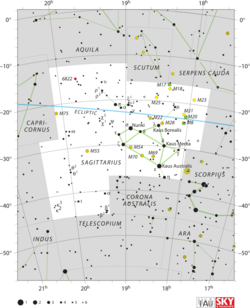Astronomy:Omega Sagittarii
| Observation data Equinox J2000.0]] (ICRS) | |
|---|---|
| Constellation | Sagittarius |
| Right ascension | 19h 55m 50.36255s[1] |
| Declination | −26° 17′ 57.6933″[1] |
| Apparent magnitude (V) | 4.70[2] |
| Characteristics | |
| Evolutionary stage | subgiant |
| Spectral type | G5 IV[3] |
| U−B color index | +0.32[4] |
| B−V color index | +0.748±0.015[1] |
| R−I color index | +0.37[4] |
| Astrometry | |
| Radial velocity (Rv) | −16.22±0.43[1] km/s |
| Proper motion (μ) | RA: 203.96[5] mas/yr Dec.: 74.40[5] mas/yr |
| Parallax (π) | 42.7159 ± 0.5538[1] mas |
| Distance | 76.4 ± 1.0 ly (23.4 ± 0.3 pc) |
| Absolute magnitude (MV) | 2.64[2] |
| Orbit[6] | |
| Period (P) | 1,712.74±0.29 d |
| Semi-major axis (a) | ≥ 1.1044 ± 0.0051 AU |
| Eccentricity (e) | 0.8200±0.0012 |
| Periastron epoch (T) | 57549.31±0.20 HJD |
| Argument of periastron (ω) (secondary) | 141.17±0.33° |
| Semi-amplitude (K1) (primary) | 12.255±0.041 km/s |
| Details[7] | |
| Mass | 1.52+0.08 −0.06 M☉ |
| Radius | 2.87+0.37 −0.34[1] R☉ |
| Luminosity | 7.1±0.1[1] L☉ |
| Surface gravity (log g) | 3.64±0.05 cgs |
| Temperature | 5,499±91 K |
| Metallicity [Fe/H] | 0.06±0.06 dex |
| Rotational velocity (v sin i) | 5.6[8] km/s |
| Age | 3.00+0.13 −0.61 Gyr |
| Other designations | |
| Database references | |
| SIMBAD | data |
Omega Sagittarii, which is Latinized from ω Sagittarii, is a binary star system in the constellation of Sagittarius,[9] near the eastern constellation border with Capricornus. It is formally named Terebellum /tɛrɪˈbɛləm/.[10][11] This system has a yellow hue and is faintly visible to the naked eye with an apparent visual magnitude of 4.70.[2] It is located at a distance of 76 light years away from the Sun based on parallax,[1] and is drifting closer with a radial velocity of −16 km/s.[1] The position of this star near the ecliptic means it is subject to lunar occultations.[12]
The members of this system orbit each other with a period of 4.6892 yr and an eccentricity of 0.82.[6] The visible component is a G-type subgiant star with a stellar classification of G5 IV.[3] It is three[7] billion years old and is spinning with a projected rotational velocity of 5.6 km/s.[8] The star is radiating seven[1] times the luminosity of the Sun from its photosphere at an effective temperature of 5,499 K.[7]
Nomenclature
ω Sagittarii (Latinised to Omega Sagittarii) is the star's Bayer designation.
This star, together with 60, 62 and 59 Sagittarii, formed the asterism called Terebellum.[13] According to a 1971 NASA memorandum, Terebellum was originally the title for four stars: Omega Sagittarii as Terebellum I, 59 Sagittarii as Terebellum II, 60 Sagittarii as Terebellum III and 62 Sagittarii as Terebellum IV .[14] In 2016, the IAU organized a Working Group on Star Names (WGSN)[15] to catalog and standardize proper names for stars. The WGSN approved the name Terebellum for Omega Sagittarii on 5 September 2017 and it is now so included in the List of IAU-approved Star Names.[10]
In Chinese, 狗國 (Gǒu Guó), meaning Dog Territory, refers to an asterism consisting of Omega Sagittarii, 60 Sagittarii, 62 Sagittarii and 59 Sagittarii. Consequently, the Chinese name for Omega Sagittarii itself is 狗國一 (Gǒu Guó yī, English: the First Star of Dog Territory.)[16]
References
- ↑ 1.0 1.1 1.2 1.3 1.4 1.5 1.6 1.7 1.8 1.9 Brown, A. G. A. (August 2018). "Gaia Data Release 2: Summary of the contents and survey properties". Astronomy & Astrophysics 616: A1. doi:10.1051/0004-6361/201833051. Bibcode: 2018A&A...616A...1G. Gaia DR2 record for this source at VizieR.
- ↑ 2.0 2.1 2.2 Anderson, E.; Francis, Ch. (2012), "XHIP: An extended hipparcos compilation", Astronomy Letters 38 (5): 331, doi:10.1134/S1063773712050015, Bibcode: 2012AstL...38..331A.
- ↑ 3.0 3.1 Keenan, Philip C.; McNeil, Raymond C. (1989), "The Perkins catalog of revised MK types for the cooler stars", Astrophysical Journal Supplement Series 71: 245, doi:10.1086/191373, Bibcode: 1989ApJS...71..245K.
- ↑ 4.0 4.1 Hoffleit, D.; Warren, Jr., W. H., The Bright Star Catalogue (5th Revised ed.), CDS ID V/50. HR 7597 , database entry. Accessed on line November 19, 2009.
- ↑ 5.0 5.1 Van Leeuwen, F. (2007), "Validation of the new Hipparcos reduction", Astronomy and Astrophysics 474 (2): 653–664, doi:10.1051/0004-6361:20078357, Bibcode: 2007A&A...474..653V.
- ↑ 6.0 6.1 Fekel, Francis C. et al. (September 2018), "Spectroscopic Orbits for Late-type Stars. II", The Astronomical Journal 156 (3): 15, doi:10.3847/1538-3881/aad3c1, 117, Bibcode: 2018AJ....156..117F.
- ↑ 7.0 7.1 7.2 Aguilera-Gómez, Claudia et al. (June 2018), "Lithium abundance patterns of late-F stars: an in-depth analysis of the lithium desert", Astronomy & Astrophysics 614: 15, doi:10.1051/0004-6361/201732209, A55, Bibcode: 2018A&A...614A..55A.
- ↑ 8.0 8.1 Luck, R. Earle (January 2017), "Abundances in the Local Region II: F, G, and K Dwarfs and Subgiants", The Astronomical Journal 153 (1): 19, doi:10.3847/1538-3881/153/1/21, 21, Bibcode: 2017AJ....153...21L.
- ↑ 9.0 9.1 "ome Sgr". SIMBAD. Centre de données astronomiques de Strasbourg. http://simbad.u-strasbg.fr/simbad/sim-basic?Ident=ome+Sgr.
- ↑ 10.0 10.1 "Naming Stars". IAU.org. https://www.iau.org/public/themes/naming_stars/.
- ↑ Terebella (3rd ed.), Oxford University Press, September 2005, http://oed.com/search?searchType=dictionary&q=Terebella (Subscription or UK public library membership required.)
- ↑ Evans, David S. et al. (November 1986), "Photoelectric observations of lunar occultations. XVI.", Astronomical Journal 92: 1210–1215, doi:10.1086/114254, Bibcode: 1986AJ.....92.1210E.
- ↑ Allen, R. H. (1963). Star Names: Their Lore and Meaning (Reprint ed.). New York: Dover Publications Inc. p. 355. ISBN 0-486-21079-0. https://archive.org/details/starnamestheirlo00alle/page/355. Retrieved 2012-09-04.
- ↑ Rhoads, Jack W. (November 15, 1971), Technical Memorandum 33-507-A Reduced Star Catalog Containing 537 Named Stars, California Institute of Technology: Jet Propulsion Laboratory, https://ntrs.nasa.gov/citations/19720005197, retrieved 2023-02-01.
- ↑ "IAU Working Group on Star Names (WGSN)". https://www.iau.org/science/scientific_bodies/working_groups/280/.
- ↑ (in Chinese) AEEA (Activities of Exhibition and Education in Astronomy) 天文教育資訊網 2006 年 7 月 2 日
 |



